Classroom Activity: D-Day
Winston Churchill and Franklin D. Roosevelt and Joseph Stalin met together in Teheran, to discuss military strategy and post-war Europe, in November 1943. Ever since the Soviet Union had entered the war, Stalin had been demanding that the Allies open-up a second front in Europe. Churchill and Roosevelt argued that any attempt to land troops in Western Europe would result in heavy casualties. Stalin had feared that without a second front, Germany would defeat them.
After lengthy discussions it was agreed that the Allies would mount a major offensive in the spring of 1944. General Dwight Eisenhower was put in charge of what became known as Operation Overlord. Eisenhower had the task of organizing around a million combat troops and two million men involved in providing support services. The plan involved assaults on five beaches west of the Orne River near Caen (codenamed Sword, Juno, Gold, Omaha and Utah) by the British 2nd Army and the American 1st Army.
The invasion was preceded by a massive aerial bombardment of German defences. The Allies also sent in three airborne divisions, two American and one British, to prepare for the main assault by taking certain strategic points and by disrupting German communications. The first to land, at 1.30 a.m. on 6th June was the 101st Airbourne Division.
At 4.00 a.m. the first wave of US glider-borne troops came in to land. These men carried the heavier weapons which the paratroopers would need to hold the perimeter. However, the German defences were now fully aware an invasion was taking place and they opened up a heavy fire and a number of the aircraft were shot down. An estimated three-quarters of the gliders did manage to reach the landing zones, but many of them crashed into thick hedgerows and stone walls. A large number of the jeeps and artillery guns brought in this way were lost.
There were necessary preliminaries to the actual beach landings. RAF Bomber Command attacked the coastal batteries, dropping almost 5,000 tons of bombs. It was a cloudy night and they had to make full use of Oboe, a radar system fitted to Mosquitoes, which marked the target for the bombers. At first light, the US Eighth and Ninth Air Forces joined in. During D-Day the Allies flew nearly 15,000 sorties, while the Germans were able to manage only 319.
By 2.00 a.m. on 6th June the minesweepers were off the beaches. Their task was to clear the approaches of mines and also the lanes which the bombarding ships would use. The bombarding ships task was to silence the German coastal batteries. Battleships were positioned some 11,000 yards from the coast. The destroyers, on the other hand, had to approach within 5,500 yards and then anchor. This made them nore vulnerable to German fire. The third group was the support landing craft, which would go in with the assaulting troops.
On the first day over 156,000 men were landed on a front of thirty miles. It was the largest and most powerful armada that has ever sailed. The Allied forces suffered 10,300 casualties.
Primary Sources
(Source A) Nikita Khrushchev, Khrushchev Remembers (1971)
Judging from what he said, I think Stalin was more sympathetic to Roosevelt than Churchill because Roosevelt seemed to have considerable understanding for our problems. In disputes during the working sessions in Teheran, Stalin found Roosevelt siding with him against Churchill. Thus, Stalin's personal sympathies were definitely reserved for Roosevelt, although he still held Churchill in high esteem.
Churchill certainly played an important role in the war. He understood the threat hanging over England, and that's why he did everything he could to direct the Germans against the Soviet Union - in order to pull the Soviet Union into war against Germany.
It's difficult to judge what the intentions of the Allies were toward the end of the war. I wouldn't exclude the possibility that they desired to put a still greater burden on the shoulders on the Soviet Union and to bleed us even more. They wanted to take advantage of the results of the war and impose their will not only on their enemy, Germany, but on their ally, the USSR, as well.
(Source B) William Leahy, chief of staff to the commander in chief of the United States, wrote about the proposed invasion of France in his autobiography, I Was There (1950).
The Russians could not have been more disappointed than our own Army people that plans for a 1942 cross-Channel invasion had to be abandoned. There was much grumbling about the British and considerable criticism of Churchill the Prime Minister was convinced that England was not ready to undertake such a major effort, and I did not think that we were either. I personally was interested in the safety or the United States. A cross-Channel operation could have failed and we still would have been safe, but England would have been lost.
I think that is what Churchill had in mind. He wanted to have much more assurance of success than General Marshall could give him. Marshall's country would have been safe, but England was sitting twenty miles across the Channel, right under the Nazi guns. England could not afford to be defeated in an invasion attempt. Churchill, in his responsibility for preserving the integrity of England, had to be satisfied in his own mind that the expedition could succeed. I cannot blame him for that.
(Source C) Winston Churchill, letter to Franklin D. Roosevelt (7th May, 1944)
I ought to let you know that the War Cabinet is unanimous in its anxiety about these French slaughters, even reduced as they have been, and also in its doubts as to whether almost as good military results could not be produced by other methods. Whatever is settled between us, we are quite willing to share responsibilities with you.
(Source D) Franklin D. Roosevelt, letter to Winston Churchill (11th May, 1944)
I share fully with you your distress at the loss of life among the French population. However regrettable the attendant loss of civilian lives is, I am not prepared to impose from this distance any restriction on military action by the responsible commanders that in their opinion might militate against the success of Overlord or cause additional loss of life to our Allied forces of invasion.
(Source F) Charles Messenger, The D-Day Atlas: Anatomy of the Normandy Campaign (2004)
The first D-Day actions by the Allies were a series of airbourne deception operations mounted by the RAF. Almost as soon as dusk had fallen on 5th June, Lancaster bombers of 617 Squadron, the Dambusters, were overflying the Straight of Dover in a precise elliptical course, dropping strips of aluminum foil known as Window. Below them sixteen small ships towed balloons fitted with reflectors. The idea was to present to the German coastal radars a picture of a convoy crossing towards the Pas-de-Calais. Stirlings of 218 Squadron were carrying out a similar exercise off Boulogne, while other Stirlings and Halifaxes dropped dummy parachutes and various devices to represent rifle fire in order to simulate airborne landings well to the south of the drop zones of the two US airborne divisions."
(Source G) Major Friedrich Hayn, a staff officer with the German Army, was in Normandy on 6th June, 1944.
At 01.11 hours - an unforgettable moment - the field telephone rang. Something important was coming through: while listening to it the General stood up stiffly, his hand gripping the edge of the table. With a nod he beckoned his chief of staff to listen in. "Enemy parachute troops dropped east of the Orne estuary. This message from 716 Intelligence Service struck light lightning.
Was this, at last, the invasion, the storming of fortress Europe? Someone said haltingly, "Perhaps they are only supply troops for the French Resistance?" While the pros and cons were still being discussed, 709 Infantry Division from Valognes announced: "Enemy parachute troops south of St Germain-de-Varreville and near Ste Marie-du-Mont. A second drop west of the main Carentan-Valognes road on both sides of the Merderet river and the Ste Mere-Eglise-Pont-l'Abbe road. Fighting for the river crossings in progress." It was now about 01.45 hours.
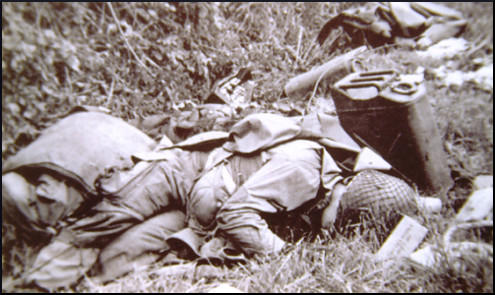
(Source I) 2nd Lieutenant Leon E. Mendel was a member of the 325 Glider Infantry, included in Remembering D-Day (2014)
My glider made a beautiful landing at Ecoqueneauville and I made my way south to my assembly point at Les Forges crossroads. Here I got the bad news that I had lost half of my six-man team in glider crashes. The good news was the others had already eight German prisoners for ininterrogation.
(Source J) Guy Remington was a member of the USA army parachuted into France on 6th June, 1944. An article about his experiences appeared in The New Yorker in July, 1944.
The green light flashed and at seven minutes past midnight. The jump master shouted, "Go!" I was the second man out. The black Normandy pastures tilted and turned far beneath me. The first German flare came arching up, and instantly machine-guns and forty-millimetre guns began firing from the corners of the fields, stripping the night with yellow, green, blue, and red tracers. Fire licked through the sky and blazed around the transports heaving high overhead. I saw some of them go plunging down in flames. One of them came down with a trooper, whose parachute had become caught on the tailpiece, streaming out behind. I heard a loud gush of air: a man went hurtling past, only a few yards away, his parachute collapsed and burning. Other parachutes, with men whose legs had been shot off slumped in the harness, floated gently toward the earth.
I was caught in a machine-gun cross-fire as I approached the ground. It seemed impossible that they could miss me. One of the guns, hidden in a building, was firing at my parachute, which was already badly torn; the other aimed at my body. I reached up, caught the left risers of my parachute, and pulled on them. I went into a fast slip, but the tracers followed me down. I held the slip until I was about twenty-five feet from the ground and then let go the risers. I landed up against a hedge in a little garden at the rear of a German barracks. There were four tracer holes through one of my pants legs, two through the other, and another bullet had ripped off both my breast pockets, but I hadn't a scratch.
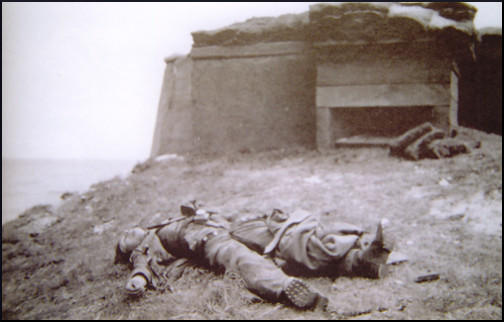
(Source L) Sergeant Thomas Valence, included in Remembering D-Day (2014)
I was the rifle sergeant and followed Lieutenant Anderson off the boat, and we did what we could rather than what we had practiced doing for so many months in England. There was a rather wide expanse of beach, and the Germans were not to he seen at all, but they were firing at us, rapidly, with a great deal of small-arm fire..
As we came down the ramp, we were in water about knee high, and we started to do what we were trained to do - moved forward, and then crouch and fire. One of the problems was we didn't quite know what to fire at. I saw some tracers coming from a concrete emplacement, which to me looked mammoth. I never anticipated any gun emplacements being that big. I attempted to fire back at that, but I had no concept of what was going on behind me. There was not much to see in front of me except a few houses, and the water kept coming in so rapidly, and the fellows I was with were being hit and put out of action so quickly that it become a struggle to stay on one's feet. I abandoned my equipment, which was very heavy.
I floundered in the water and had my hand up in the air, trying to get my balance, when I was first shot. I was shot through the left hand, which broke a knuckle, and then through the palm of the hand. I felt nothing but a little sting at the time, but I was aware that I was shot. Next to me in the water, Private Henry G. Witt was rolling over towards me. "Sergeant, they're leaving us here to die just like rats." I certainly wasn't thinking the same thing, nor did I share that opinion. I didn't know whether we were being left or not.
I made my way forward as best I could. My rifle jammed, so I picked up a carbine and got off a couple of rounds. We were shooting at something that seemed inconsequential. There was no way I was going to knock out a German concrete emplacement with a .30-caliber rifle. I was hit again, once in the left thigh, which broke my hipbone and a couple of times in my pack, and then a bullet severed my chin strap on my helmet. I worked my way up onto the beach, and staggered up against a wall, and collapsed there. The bodies of the other guys washed ashore, and I was one live body amongst many of my friends who were dead and, in many cases, blown to pieces.
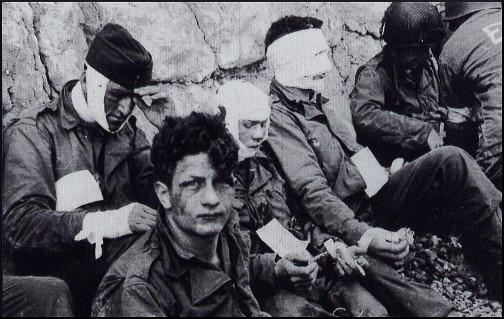
(Source N) James Bramwell Byrom, was a British paratrooper who landed in Normandy on 7th June, 1944. He wrote about it in his book, The Unfinished Man (1957)
A dog barked at my approach. From the corner of my eye I could see a stealthy figure flit from behind a haystack into the shadow of the barn. There was no answer to my first knock. The household was obviously fast asleep. I knocked louder, and this time I heard a scurrying on the stairs and a sudden clamour of French voices. Footsteps approached the door, withdrew, hesitated, then approached again. The door opened.
On the way I had been searching for suitable words with which to introduce ourselves - some calming, yet elegant, phrase worthy of the French gift of expression and of their infallible flair for the dramatic moment. But at the sight of the motherly, middle-aged peasant the gulf of the years disappeared, and I might have been back in 1939, an English tourist on a walking tour dropping in to ask for a glass of cider and some camembert.
"Excusex-nous, Madame. Nous sommes des parachutists anglais faisant partie du Débarquement Allié."
There was a moment of scrutiny, then the woman folded me in her arms. The tears streamed down her face, and in between kisses she was shouting for her husband, for lamps, for wine. In a moment, I was carried by the torrent of welcome into the warm, candle-lit kitchen. Bottles of cognac and Calvados appeared on the table, children came clattering down the wooden stairs, and we found ourselves - an evil-looking group of camouflaged cut-throats - surrounded and overwhelmed by the pent-up emotions of four years.
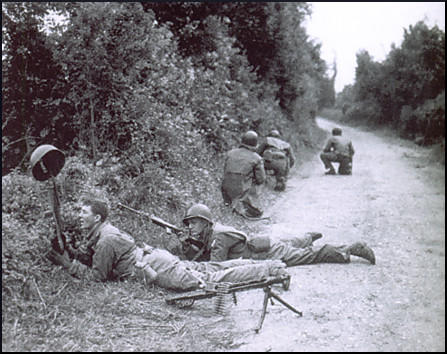
(Source P) Anne Frank, diary entry (6th June, 1944)
"This is D-day", came the announcement over the British radio. The invasion has begun! According to the German news, British parachute troops have landed on the French coast. British landing craft are in battle with the German Navy, says the BBC.
Great commotion in the 'Secret Annexe'! Would the long-awaited liberation that has been talked of so much but which still seems too wonderful, too much like a fairy-tale, ever come true? Could we be granted victory this year, 1944? We don't know yet, but hope is revived within us; it gives us fresh courage, and makes us strong again.
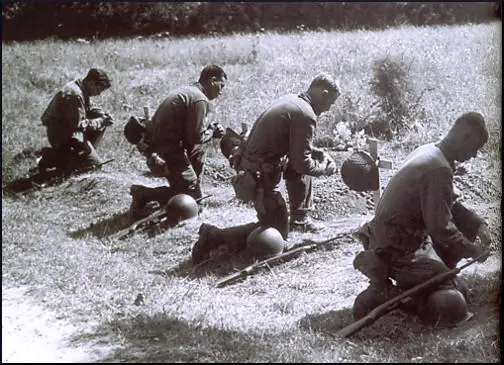
Questions for Students
Question 1. Read Sources A and B. How do these authors disagree about the motivations of Winston Churchill at in Teheran in November 1943? Can you give any reasons for this disagreement?
Question 2: Read Sources C and D. Why would historians be interested in reading the private letters of politicians when writing about D-Day?
Question 3: What does Source F tell us about Allied military strategy during Operation Overlord? Select another source from this unit to show the success of this strategy.
Question 4: Read Sources J and L. Explain the different problems faced by paratroopers and the infantry on D-Day.
Question 5: Look at Source O. What is the American soldier doing?
Question 6: Study sources E, H, K, M, O and Q. Explain which of these photographs would have been published in British newspapers during the days following the D-Day landings?
Question 7: Compare the emotions expressed by the women in sources N and P.
Question 8: In the interview with Jim Radford (Source Q), he talks about the motivation behind writing The Shores of Normandy. Listen to the interview and the song and explain in your own words the message that Jim Radford is trying to convey.
Answer Commentary
A commentary on these questions can be found here
Download Activity
You can download this activity in a word document here
You can download the answers in a word document here
